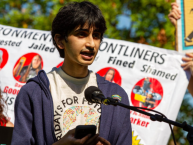
Name: Dillon DalalSurana
Social Justice Group: 2022-2023, Environment: Microplastics
Date of Fieldwork: January 12, 2023
Name of Organization and person (people) with whom you met and their title(s):Plastic Pollution Coalition
Type of Fieldwork: Webinar
What I did and what I learned about my topic, activism, social justice work or civil and human rights work from this fieldwork?:
I attended a webinar with the Plastic Pollution Coalition on the topic of microfibers. The webinar discussed where and how microfibers are formed. Micro and nano fibers can be traced back to many sources. A few big sources are tire marks, degrading plastic on land and in the sea. Studies have found that most plastic water bottle companies have hundreds, sometimes thousands of pieces of nano plastic in all plastic water bottles. For nano fibers, one of the biggest contributors are washing machines. Their filters aren’t fine enough to catch the majority of microfibers and they leech into sewers and then eventually end up in estuaries or even the ocean. Fortunately, a company called Planet Care has made washing machine filters that collect up to 90% of microfibers. These microfibers are thrown into landfills to properly dispose of them instead of having them float in water for animals to consume them. Also, more than 50% of clothing is made with some kind of plastic material. It would be better to use other materials than plastic to help to lower the production and consumption of plastics.
After listening to the webinar, one of the many takeaways is that my household must create many pounds of microfibers over the course of a year contributing to microplastics in the environment. It also makes me more interested in purchasing clothing made from natural fibers vs. synthetics/plastic. If we all can make little changes, we can be part of the solution.





